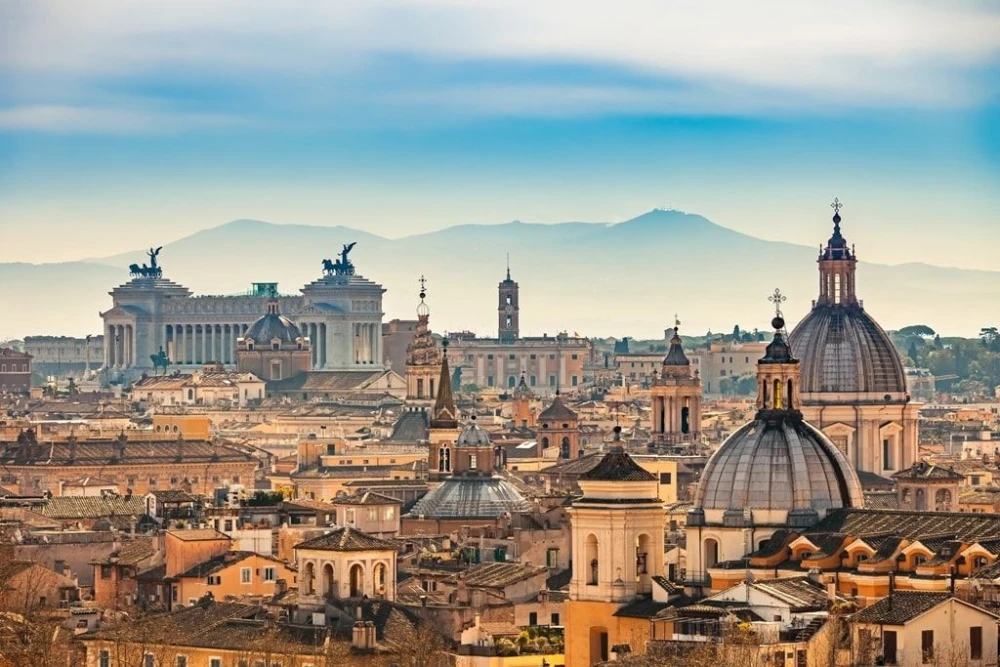15124, Maroysi, Athens, Greece
Lisbon, Cadiz, Tangier, Valencia, La Valletta, Salerno-, Civitavecchia (Rome), Livorno, Portofino, Marseille (Provence), Gibraltar, Barcelona

Lisbon, the capital of Portugal, on the southwest of the country, has been the main gateway for the rest of the planet for more than 19 centuries. Ships captained by Portuguese explorers like Bartolomeu Dias, Vasco da Gama and Ferdinand Magellan, skittered across the globe, hauling treasure home and making Lisbon a global capital. Draped across seven hills, Lisbon was once the center of a vast maritime empire that stretched from the west coast of Africa to the Spice Islands of the East Indies, until 1755, when a violent earthquake destroyed two-thirds of the city, leaving intact only the Alfama, the old Moorish quarter. Today, Lisbon is a stately city of Neoclassical buildings and wide plazas. Eternally linked to the sea, Lisbon's magnificent harbor is spanned by the longest suspension bridge in Europe. Among the city's landmarks are the iconic Castelo de São Jorge, the World Heritage Sites of Belém Tower and Jerónimos Monastery, both built in Lisbon's native Manueline architectural style.
Cadiz is a city and port in southwestern Spain, the oldest continuously-inhabited city in Spain and one of the oldest in southwestern Europe. During the Age of Exploration, the city experienced a renaissance. Christopher Columbus sailed from Cádiz on his second and fourth voyages and the city later became the home port of the Spanish treasure fleet.
Cadiz is the gateway to Seville, capital of Andalucia, which lies on the mighty Guadalquivir at a distance of 120 kms. Taking a tour to Seville, will give you a change to marvel the Alcazar, a grand 14th Century Moorish palace, the Seville Cathedral and the Archivo de Indias, all UNESCO World Heritage sites, built in the Mudejar style, and also, to walk the narrow lanes of the Jewish
Quarter, the expanse of the Plaza de Espana, or the halls of the Museo de Bellas Artes.
Tangier is part of the Kingdom of Morocco, Africa's whitewashed gateway to Europe and the Mediterranean, a rich blend of cultures, exotic souks, colourful riads, the Kasbah, lively markets.. Wide palm-lined boulevards and humming souks are Tangier's distinctively Moroccan characteristics, but Spanish, French and Berber influences are found everywhere: watch the arched wooden doors, the hefty silver ornamentations, the tighly-woven carpets that tell tribal legends.You can take a tour at the caves of Hercules and the colourful souks of the Old Medina, the Kasbah and the majestic mountains of the Rif.
Since its founding as a Roman colony in 138 B.C., the Visigoths, the Moors, the Catalan and Aragonese and the modern tomato-throwers have thrived on the shores of the Mediterranean at the Gulf of Valencia. Valencia is a mix of the old and the new. The historic past is depicted in the stone geometry of the Valencia Cathedral, the mediaeval gates of the Serrano and Quart towers, or the Tribunal de las Aguas (Water Court) and one of the most iconic examples of Gothic architecture in Europe, the Lonja de la Seda, declared an Intangible Cultural Heritage site by UNESCO. The new facet is embodied in the arching white steel of the futuristic City of Arts and Sciences, designed by Valencian architect Santiago Calatrava.

Valletta, The Fortress City, Citta' Umilissima, "a city built by gentlemen for gentlemen" is Malta's capital city: a living, working city, the administrative and commercial heart of the Islands. The city is busy by day, yet retains a timeless atmosphere. The grid of narrow streets boasts some of Europe's finest art works, churches and palaces, among which St. John's Co-Cathedral, with its elaborate inlaid marble tombstones and Caravaggios and the Grand Master's Palace. Enjoy visiting the famous Three Cities across the Grand Harbour and if you have time, Sliema/ St. Julian's/ Paceville area, renowned for its cosmopolitan feel and lively nightlife.

Valletta, The Fortress City, Citta' Umilissima, "a city built by gentlemen for gentlemen" is Malta's capital city: a living, working city, the administrative and commercial heart of the Islands. The city is busy by day, yet retains a timeless atmosphere. The grid of narrow streets boasts some of Europe's finest art works, churches and palaces, among which St. John's Co-Cathedral, with its elaborate inlaid marble tombstones and Caravaggios and the Grand Master's Palace. Enjoy visiting the famous Three Cities across the Grand Harbour and if you have time, Sliema/ St. Julian's/ Paceville area, renowned for its cosmopolitan feel and lively nightlife.

Our gateway to the Eternal City, Civitavecchia has served as Rome's seaport since the 13th century, boasting a long and venerable history. Its location near the modern city, made it a perfect vacation resort for emperor Trajan, who built a pleasure villa. while Bernini and Michelangelo designed the harbor fortifications. Yet the Eternal City, the ancient capital of the Western World and the center of Christianity for nearly 2.000 years, is our main reason to be here. YYou can visit the ruins of the Forum and the Colosseum, throw a coin in Fontana di Trevi to make sure you return to Rome one day, take a photo in front of the Vatican, view the splendors of the Sistine Chapel or climb the Spanish Steps, once the heart of Rome's Bohemian Quarter and enjoy a delicious gelato, in the glamorous area.

Our gateway to the Eternal City, Civitavecchia has served as Rome's seaport since the 13th century, boasting a long and venerable history. Its location near the modern city, made it a perfect vacation resort for emperor Trajan, who built a pleasure villa. while Bernini and Michelangelo designed the harbor fortifications. Yet the Eternal City, the ancient capital of the Western World and the center of Christianity for nearly 2.000 years, is our main reason to be here. YYou can visit the ruins of the Forum and the Colosseum, throw a coin in Fontana di Trevi to make sure you return to Rome one day, take a photo in front of the Vatican, view the splendors of the Sistine Chapel or climb the Spanish Steps, once the heart of Rome's Bohemian Quarter and enjoy a delicious gelato, in the glamorous area.
Livorno, Tuscany's second-largest city, is the maritime gateway to the Tuscany region and its two most known cities, Florence (to the west) and Pisa (to the north). Among Livorno's main attractions are the Cisternone, an impressive neoclassical building on Viale Giosue Carducci, designed like a Roman bath, the main city square Piazza della Repubblica with Fortezza Nuova (the castle dating back to around 1576) in the background and a number of interesting shops in the city centre that visitors can explore. Florence, the cradle of the Renaissance, is home to the Duomo, the Uffizi and the Ponte Vecchio. Pisa contains a host of beautiful cathedrals, palaces and bridges over the Arno River, as well as its glorious Leaning Tower, monument to faulty engineering.
Portofino is an Italian resort, located on the Italian Riviera, famous for its picturesque harbor with the colourfully painted buildings. It is the favorite destination of many celebrities and artists.

Marseille is the largest port on the Mediterranean, France's second largest city and a virtual melting pot of peoples and cultures. It is a unique city with a feel and culture all its own. It is also a place of striking contrasts, from the fishing boats of the picturesque Vieux Port to the modern Canebiere. Dominating the harbor is the infamous Chateau d'If, the rocky prison from which Alexandre Dumas' "Count of Monte Cristo" escaped. If you have time, explore the countryside around Arles and Avignon, immortalized in the canvases of Van Gogh, Cezanne, Matisse and Picasso, try the renowned bouillabaisse or tour the lovely towns and vineyards of Provence.
Gibraltar is an amazing co-mingling of past, present and future.The Rock of Gibraltar was considerred by the Ancient Greeks as the pillars of Hercules, marking the end of the world. It is at the Top of the Rock where you begin to understand and appreciate Gibraltar’s strategic geographical location and the important role it has played throughout history. The journey to the top of the Rock rewards you with a truly breathtaking view. From a height of 426m you will see the African coastline, where the waters of the Atlantic meet the Mediterranean, Spain’s Costa del Sol and a panoramic view of the City far below, the quays, marinas and bays. Stand on top of the Rock of Gibraltar and you feel as if you were on top of the world.

Barcelona is one of the world's greatest treasures, a global capital of commerce, fashion, culture and sunshine. Cruise visitors should start with a walk down Las Ramblas, the glorious tree-shaded thoroughfare at the heart of the city, enjoy a dive in the wonderful beaches nearby, but, most of all, see what visionary architect Antoni Gaudi wrought. Seven of his creations have been honored as UNESCO World Heritage Sites, including La Sagrada Familia, the Park Guell and Casa Mila. Time provided, you can also visit the former Olympic Ring on the hill of Montjuic, home to world-class parks, fountains and museums. Barcelona, which nurtured such artistic giants as Picasso, Dali, Miro and Casals, is definitely a traveler's paradise.
Itinerary







